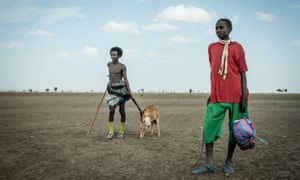A pilot report assessing global food security has been published as a part of a new joint network between FAO, WFP and EU
27 May 2016
by
Eatglobe
Source: Food and Agriculture Organization of the United Nations (FAO), the UN World Food Programme (WFP) and the European Union
A girl eating raw maize from a bag in Halachaharabate village, West Arsi Zone, Oromia region, in Ethiopia, 11 November 2009
EPA
A new network to conduct real-time food security assessments around the world was launched this Monday by the Food and Agriculture Organization of the United Nations, the UN World Food Programme and the European Union. The collective effort will result in regular reports that will prompt timely and more adequate responses to food crises and encourage joint responses.
The network's first pilot report was published this March with an assessment of the food and nutrition security status of 70 countries that were affected by a food crisis in 2015. The crises were caused by either natural phenomena such as El Niño; disasters such as earthquakes, floods, drought; or protracted crises, namely prolonged armed conflicts. The report will serve as a guidance at how to fairly distribute the 539 million Euro pledged by the European Commission to help countries in need.
Young Ethiopian girl going for water near the capital city Addis Ababa, 1 May 2015
According to the report, some 240 million people across 70 countries are food insecure. Nearly half of them live in El Niño-affected countries.
Ethiopia, the second most populous country in Africa, has the highest number of food insecure individuals – 10.2 million people, which is 10.3 percent of the nation's total population. The factor responsible for the severe food insecurity was a strong El Niño-driven drought, which wreaked havoc on crop production and has led to the death of more than 200 000 livestock across the country.
In relative terms, the situation in the small Pacific island country of Vanuatu is even worse, as the 0.166 million food insecure individuals represent 61 percent of the nation's population. Vanuatu, thus, ranks as the country with the highest percentage of total population struggling with food insecurity. The assessment shows that the food crisis was also brought by the El Niño phenomenon together with severe floods by cyclones and an ongoing armed conflict.
A woman prepares food for her son in front of their home ruined after the Cyclone Pam hit the island of Tanna, Vanuatu, 17 March 2015
EPA
Military conflicts are also the main driver of food crisis in countries in the Middle East, such as Syria, Iraq and Afghanistan, as well as the Democratic Republic of the Congo in Central Africa, where illegal mining activities cause the hunting and trading of many endangered species valued for bushmeat.
In Asia, 43 percent of the population of Democratic People’s Republic of Korea is also food insecure due to El Niño and water scarcity in crop irrigation, which caused a 9 percent drop in food production for the first time since 2010. This is a painful hit for North Korea, which is already one of the poorest countries in the world, as agriculture accounts for 21 percent of the country's income and is a major provider of employment.
The assessment provides detailed information on the food security situation in many of the most malnutrition-affected countries. However, it is unclear why India, the country with the second-highest estimated number of undernourished people in the world, was not included in the report.
A broom maker prepares food for his family in the outskirts of Srinagar, Kashmir, India, 10 June 2015
EPA
Monica is one of Eatglobe's staff writers and the whiz kid behind our social media strategy.
Send an email to Monica
Send an email to Monica



